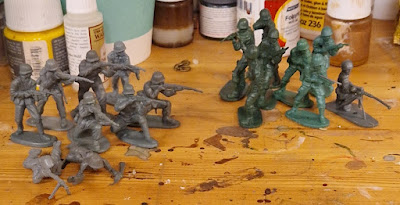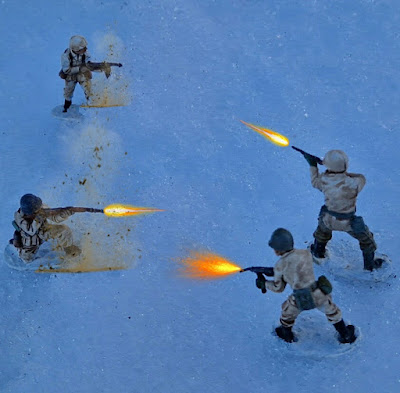Today it's exactly 80 years since Operation Overlord and the world's largest amphibious operation ever; The D-Day landings in Normandy 6th of June 1944, which gave the Allied forces a bridgehead onto the Nazi occupied continent. The 6th of June has also another meaning to me related to WW2 which I'll come back to a little later in this blogger-post.
D-Day landings
Some 1950 Norwegians was involved in the operation in both own Norwegian units or part of other allied units. In addition 45 Norwegian cargo ships with about 1000 Norwegian crew-members also participatied. I'm not going to give a general resume about the
D-Day landings in Normandy it self in this Blogger-post, but if you wants to know even more about it I really recommend Antony Beevor's book '
D-Day - The Battle for Normandy'. This book is actually so good and informative that my late friend Morten and I used it as a travel-guide when visiting Normandy back in June 2014, as it showed us all the places of interests to visit. Morten was also my friend who introducing me to the idea of miniature wargaming in the first place.
So today it's probably appropriate to pack some food and beverages in my backpack and take a short trip to the coast (their day at the beach made it possible for us to have a day at the veach), and I thought it was a good cause to bring some few miniatures too...
 |
| Coffee in one vacuum-flask and hotdogs in the other |
D-Day Wargaming
I brought some of those miniatures
I got earlier this year in my backpack as well. I haven't got around to painting them yet, but The Americans are molded in classic green plastic, and the Germans are molded in classic grey plastic, and I thought bringing them for some 'classic toy soldier' photos by the sea or a 'classic toy soldier wargame' would be appropriate.
Since it's exactly 80 years since the D-Day landings today and I'm at the seaside, I chose a 'D-Day-themed Scenario'; A US Ranger squad of 12, divided into 3 fireteams of 4, armed with a LMG and a Bazooka is ordered to neutralize a German gun emplacement on Omaha Beach. The single German gun they're assigned to is part of a larger battery, and is located in a fortified position. The German gun is manned and defended by a German squad of 10, divided into 3 fireteams of 3 and an officer and they have a LMG.
The American Ranger Squad are landing at the beach...
...where the German defenders are awaiting them:
The Germans immediately opens fire on the advancing Americans. With 1 BC Toy Soldiers Rules, I treated the Gun like a 'Bazooka' but with range as far as LoS:
A German shell kills half of one of the American fireteams. The American weapons are not effective on this range, so they start running for cover trying to get closer to that German gun emplacement.
The German gun fires another shell...
...and get a direct hit on the American GPA. The Rangers leaves it behind, keep moving towards cover and closer to the German positions...
...but to reach some cover they need to cross a wide open 'kill zone', simultaneously as the German gun keeps decimating them.
The Ranger firingteam with the Bazooka finally reaches cover, and the German positions are in range of their weapons. They don't hesitate and fire a grenade...
...which is a direct hit, and knocks out a German foxhole...
...which again allows the American firingteam with the LMG to advance closer to cover and trying to get out of LoS for the deadly German gun.
The Rangers didn't quite reach cover and get out of LoS og that Gun before it fired another shell. -And got a direct hit...
The only 2 surviving Americans runs for cover with their LMG. They got out of LoS for the Gun, and in range with their LMG. They immediately opens fire:
When the enemy are in range, so are you (!)
The Germans advances to better get the last Americans in sight for their weapons, and exchanges fire for another turn. The Germans finally finishes them off after about 12 turns and 1 hour.
What the remaining German squad does not realize at this time, is that further 156 000 allied soldiers are about to land in their area...
The other importance of 6th of June to me, and it's WW2 relevance
The other reason why the 6th of June is important to me is simply because my Granduncle, "Uncle Bertram" was born on this date in 1905 (the same year Norway got independent from the forced union with Sweden dating back to 1814). "Uncle Bertram" was like a "Grandpa" to me when I grew up, and we were very close.
 |
| 'Onkel Bertram' to the right. |
During the German occupation of Norway in WW2 there were a lot of people that was wanted by the Germans due du illegal activities, ethnicity, belief or being Jews and needed to escape not only from the occupation authorities but also needed to flee the country. Many escaped to the neutral Sweden as it was close and could be reached either by land or sea.
Despite not living at the island of Hvasser at the outbreak of the war "Onkel Bertram" was registered as a 'fisherman' where he grew up and were therefore allowed to stay and travel in these coastal areas close to Sweden only separated by
Skagerrak. My Granduncle got involved with the resistance movement and operated a ship in the organized refugee traffic as a captain. First he used his father's old but 'smaller' boat, but later a larger fishing vessel "Anna" was aquired by the Swedish authorities and registered in Norway (!). This was an achievement as all registers went through the German occupation authorities (!).

He made numerous tours between occupied Norway and neutral Sweden over Skagerrak, transporting refugees to Sweden, and bringing critical supplies like food, medical supplies, clothes and shoes back to Norway as there was a critical shortage of such. Some total of 1600 refugees were 'smuggled' to Sweden over Skagerrak on various boats and ships during WW2 from this area alone.
The Germans were aware of this illegal activities and tried to prevent it. They deployed 8 'patrol-ships' in this district in an attempt to disclose the activities, and it was often an 'cat/mouse chase' between the German patrol- ships and the Norwegian refugee-ships. Being local Uncle Bertram told that the Norwegians had an advantage with local knowledge and knowing the coast very well, and where it was possible to sail or not. Often in waters and under weather conditions and in the cover of the darkness the Germans didn't dare to sail.
The refugee-ships managed to operate under cover of being ordinary fishing-vessels. Fishing was considered important as there was critically shortage of food in Norway. But the vessels involved in the refugee-traffic had no time to do any fishing them self during their missions and operations, so to make their cover as fishing vessels plausible, they were often given some of the catch from other ordinary fishing vessels on their way back to Norway, blending in with the rest of the fishing-fleet.
Uncle Bertram told me that his ship came under machine-gun fire once, when they tried to avoid a control by a German patrol-ship in the cover of darkness. Before they recived any critical hits, he told me that he returned fire with a rifle he had onboard. He told that he was never sure if he hit or not as it was so dark, but that his returning fire resulted in that the Germans ceased fire and aborted their chase on them, and they were able to slip away into the darkness again.
When the leader of the Norwegian Resistance Movement, Jens Christian Hauge was on one of his meetings in Sweden to met representatives of the Norwegian Army Command in exile, he
requested that Uncle Bertram executed the transport with his ship "Anna".
After WW2 his ship "Anna" was handed over to Swedish authorities again. When returning the ship, one of the Swedish servicemen asked him if there were anything he wanted from the ship as it was going to be scrapped anyway. Uncle Bertram replied that he wanted the compass, which he was granted. This was later used in his father's boat, in which he had started the coastal refugee traffic in the first place. Not much after years of service. He was neither granted 'war pension' when retiring. Later he handed the compass, and the only thing left from "Anna", over to me:
I think the 6th of June is a good day to remember not only those fighting in Normandy, but also being his birthday remembering "Onkel Bertram" and honor his service. Thank you!



















































.jpg)

















.jpg)





